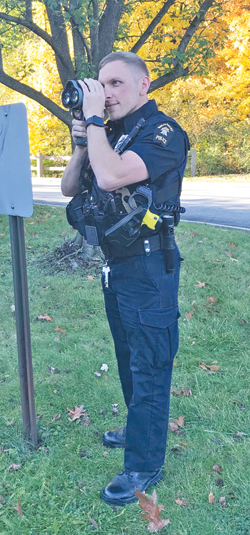Police aided by high-tech equipment purchases
by Dan Holland
The Independence Police Department’s recent acquisition of high-tech equipment, including new Getac body-worn cameras and handheld Stalker RLR Lidar units, is a crucial step in keeping up with 21st-century law enforcement techniques, according to Police Chief Robert Butler.
“We have definitely worked hard on listening to the officers and getting the equipment that they need to do their jobs most effectively,” said Butler. “We want to be a progressive department that is at the cutting edge to stay ahead of the criminal element.”
The city was awarded $59,107 through the Ohio Body Worn Camera Grant Program to purchase approximately 30 units, which the police department started using in August.
The body cams, which are detachable from officers’ uniforms, go into a multiport recharging station while simultaneously uploading all videos to a cloud storage system that Getac maintains. The public can view specific videos through a public records request.
“If it’s an active investigation or something ongoing, we wouldn’t be able to release it until that process is completed,” explained Det. Andrew March. “With certain sensitive things, we have to make a decision on what gets redacted and what doesn’t to protect victims or injured persons.”
Videos in the cloud storage system are placed into various categories and the amount of time the video is available before being purged varies.
“Some get purged depending on the type – some are 90 days; some are two years, and some are perpetual,” explained March. “With other videos, you can delineate which category that video would go into. Some can be moved into the ‘other’ file category, and those get purged after 30 days if it’s something minor.”
The body cams protect officers while providing transparency to the public, said Butler. “Officer safety is the most important thing to us; being able to get a view that we wouldn’t have been able to see before,” he said. “It saves officers from potential complaints, and they can also be used for training purposes.”
Butler added, “This allows us to get out information quickly to the media or to our residents to show them what’s going on and how we’re handling any issues that are facing Independence.”
Body cams are instrumental during OVI stops and can also pinpoint an officer’s location and indicate if he or she is in a horizontal position rather than a vertical one, meaning something has gone wrong.
“When we have to do an OVI report, all of the field sobriety testing will be captured on the body cam and we can review which tests the driver failed and put that in our report,” said Patrolman Michael March.
The department purchased two Stalker RLR Lidar units (speed guns), at a cost of $2,500 each, within the last six months. The new units are lighter, easier to use and provide better functionality for tracking vehicle speeds, said Butler. Independence officers chose the brand.
“We had a manufacturer come out, and they gave us one to demo,” Butler explained. “The officers took it out on patrol, and it was their support that got us that unit. We used to use the Laser Tech units; now we use the Stalkers.”
“One of the biggest factors is that we can shoot laser in rain and snow unlike the old units, which had limited distance,” said Patrolman Kevin Fuka. “There was no way for the laser to penetrate through the elements. With the new technology, we can go thousands of feet out if we need to.”
Other recent technology purchases include blue light observation cameras, for general monitoring in the city, and a thermal spotlight drone, which can locate missing persons or suspects by detecting body heat. New dash cams for police cruisers are also being explored. ∞

Pictured left is the old Laser Tech unit compared to the new Stalker RLR unit on the right. Photo by Dan Holland.
Photo (main/above): Officer Kevin Fuka calibrates a Stalker RLR Lidar unit behind the police station. Photo by Dan Holland.

